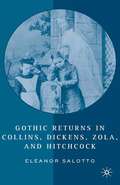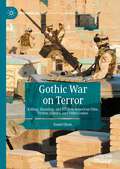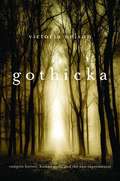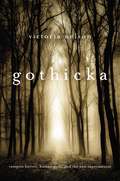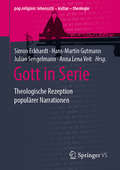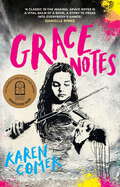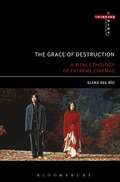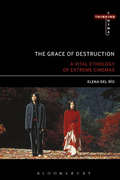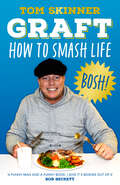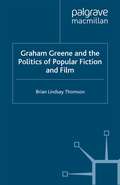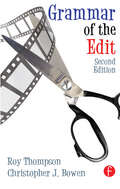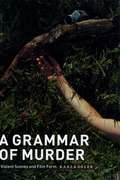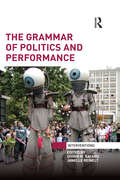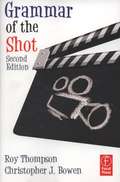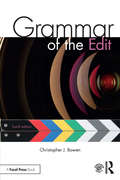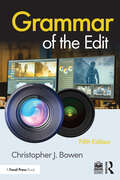- Table View
- List View
The Gothic Peckinpah
by Tony WilliamsThis book argues for the importance of Gothic in understanding one of the key elements within the films of Sam Peckinpah (1925-1984). Although occasionally noted in the past, the Gothic has been generally overlooked when most critics consider the work of Sam Peckinpah with the exception of the Freudian based Crucified Heroes (1979) by Terence Butler. This work not only examines the films made after that date, especially the often dismissed The Osterman Weekend (1983) and the two music videos he made for Julian Lennon, but also places the director within the context of the developing work on Gothic that has since appeared. Peckinpah has been identified as the director of one undisputed masterpiece, The Wild Bunch (1969). By focussing on the key role Gothic plays in most of the director’s work, this book offers a way to see Peckinpah beyond The Wild Bunch and the Western, viewing him as a director who had the potential of evolving further, had circumstances permitted, to continue his critique of American life within the developing lens of the Gothic.
The Gothic Peckinpah
by Tony WilliamsThis book argues for the importance of Gothic in understanding one of the key elements within the films of Sam Peckinpah (1925-1984). Although occasionally noted in the past, the Gothic has been generally overlooked when most critics consider the work of Sam Peckinpah with the exception of the Freudian based Crucified Heroes (1979) by Terence Butler. This work not only examines the films made after that date, especially the often dismissed The Osterman Weekend (1983) and the two music videos he made for Julian Lennon, but also places the director within the context of the developing work on Gothic that has since appeared. Peckinpah has been identified as the director of one undisputed masterpiece, The Wild Bunch (1969). By focussing on the key role Gothic plays in most of the director’s work, this book offers a way to see Peckinpah beyond The Wild Bunch and the Western, viewing him as a director who had the potential of evolving further, had circumstances permitted, to continue his critique of American life within the developing lens of the Gothic.
Gothic Returns in Collins, Dickens, Zola, and Hitchcock
by E. SalottoLooking at the gothic in Victorian fiction, the development of cinema and Hitchcock's Vertigo , this book explores the contained or repressed desires of both characters and plots which defy direct representation, resulting in obsession, fetishism and displacement engendering a novel account of the way in which the gothic becomes internalized.
Gothic War on Terror: Killing, Haunting, and PTSD in American Film, Fiction, Comics, and Video Games (Palgrave Gothic)
by Danel OlsonAfter 9/11, the world felt the “shock and awe” of the War on Terror. But that war also exploded inside novels, films, comics, and gaming. Danel Olson investigates why the paranormal, ghostly, and conspiratorial entered such media between 2002-2022, and how this Gothic presence connects to the most recent theories on PTSD. Set in New York/Gotham, Afghanistan, Iraq, and CIA black sites, the traumatic and weird works interrogated here ask how killing affects the killers. The protagonists probed are artillery, infantry, and armored-cavalry soldiers; military intelligence; the Air Force; counter-terrorism officers of the NYPD, NCIS, FBI, and CIA; and even the ultimate crime-fighting vigilante, Batman.
Gothicka: Vampire Heroes, Human Gods, And The New Supernatural
by Victoria NelsonThe Gothic has taken a revolutionary turn in this century. Today’s Gothic has fashioned its monsters and devils into heroes and angels and is actively reviving supernaturalism in popular culture. Nelson argues that this mainstreaming of a spiritually driven supernaturalism is a harbinger of what a post-Christian religion in America might look like.
Gothicka: Vampire Heroes, Human Gods, And The New Supernatural
by Victoria NelsonThe Gothic has taken a revolutionary turn in this century. Today’s Gothic has fashioned its monsters and devils into heroes and angels and is actively reviving supernaturalism in popular culture. Nelson argues that this mainstreaming of a spiritually driven supernaturalism is a harbinger of what a post-Christian religion in America might look like.
Gott in Serie: Theologische Rezeption populärer Narrationen (pop.religion: lebensstil – kultur – theologie)
by Simon Eckhardt Hans-Martin Gutmann Julian Sengelmann Anna Lena VeitDer Sammelband beschäftigt sich mit Serien als festem Bestandteil gegenwärtiger Popkultur, die Erzählmuster bekannter Hollywoodformate ablösen. In den Großerzählungen der Serienlandschaft werden religiöse Themen explizit und implizit verhandelt und zum handlungstragenden Element.
Grace Notes
by Karen ComerThis song has a grace note,a tiny note that's there for embellishmentbut can easily be ignored,not played.Tonight, I add it in -just because.We can all do with an extra noteof grace.Grace Dalfinch is a talented violinist who longs to play contemporary music in bars, but her mum forbids her. James Crux is an aspiring street artist who promised his dad he wouldn't paint in public until he's finished school. When Crux witnesses Grace's impromptu performance on a deserted tram, he's inspired to paint her and her violin; and when Grace stumbles across her portrait in a Melbourne alley by an anonymous street artist, she sets out to find its creator.Grace Notes is a debut YA verse novel, set in one of the most locked-down cities in the world - Melbourne, 2020. For fans of Cath Crowley and Pip Harry.'A classic in the making; Grace Notes is a vital balm of a book, a story to press into everybody's hands.'DANIELLE BINKS'Poetry, music and art, woven together in an uplifting story about endless lockdowns and first love.'NOVA WEETMAN'Comer captures the beats of Melbourne's 2020 and the unique experience of a generation of teens in one of the most locked-down cities in the world.'Books+Publishing'Heart and soul triumph over Covid lockdowns and restrictions . . . Karen has used the verse novel to beguile, dance and demand layers of emotion and depth that only poetry can sustain. A masterful debut!'LORRAINE MARWOOD'Like the grace note of the title, this beautiful story strikes the perfect tone, mixing colour, light and music at a time when we needed it most.'NICOLE HAYES
The Grace of Destruction: A Vital Ethology of Extreme Cinemas (Thinking Cinema)
by Elena Del RíoFor Elena del Río, extreme cinema is not only qualitatively different from the representations of violence we encounter in popular, mainstream cinema; it also constitutes a critique of the socio-moral system that produces (in every sense of the word) such violence. Drawing inspiration from Deleuze's ethics of immanence, Spinoza's ethology of passions and Nietzsche's typology of forces, The Grace of Destruction examines the affective extremities common in much of global, contemporary cinema from the affirmative perspective of vital forces and situations-extremities such as moral/religious oppression, biopolitical violence, the pain involved in gender relations, the event of death and planetary extinction. Her analysis diverges from the current literature on extreme cinema through its selection of films, which include key international examples, and through its foregrounding of relational, affective politics over representations of sexuality and graphic violence. Detailed formal and philosophical analyses of films like The White Ribbon, Dogville, Code Unknown, Battle in Heaven, Sonatine, Fireworks, Dolls, Takeshis', Inland Empire and Melancholia are meant to move us away from the moral appraisal of violence and destruction, and to compose an ethological philosophy of cinema based on Deleuze's idea that, "when truth and judgment crumble, there remain bodies, which are… nothing but forces.†?
The Grace of Destruction: A Vital Ethology of Extreme Cinemas (Thinking Cinema)
by Elena Del RíoFor Elena del Río, extreme cinema is not only qualitatively different from the representations of violence we encounter in popular, mainstream cinema; it also constitutes a critique of the socio-moral system that produces (in every sense of the word) such violence. Drawing inspiration from Deleuze's ethics of immanence, Spinoza's ethology of passions and Nietzsche's typology of forces, The Grace of Destruction examines the affective extremities common in much of global, contemporary cinema from the affirmative perspective of vital forces and situations-extremities such as moral/religious oppression, biopolitical violence, the pain involved in gender relations, the event of death and planetary extinction. Her analysis diverges from the current literature on extreme cinema through its selection of films, which include key international examples, and through its foregrounding of relational, affective politics over representations of sexuality and graphic violence. Detailed formal and philosophical analyses of films like The White Ribbon, Dogville, Code Unknown, Battle in Heaven, Sonatine, Fireworks, Dolls, Takeshis', Inland Empire and Melancholia are meant to move us away from the moral appraisal of violence and destruction, and to compose an ethological philosophy of cinema based on Deleuze's idea that, “when truth and judgment crumble, there remain bodies, which are… nothing but forces.”
Graham Greene and the Politics of Popular Fiction and Film
by B. ThomsonOne of the most popular, respected and controversial writers of the twentieth century, Greene's work has still attracted relatively little scholarly comment. Thomson charts the intricate dance between his novels and screenplays, his many audiences, and an intellectual establishment reluctant to identify the work of a popular writer as 'literature'.
Grain & Noise - Artists in Synthetic Biology Labs: Constructive Disturbances of Art in Science (Image #221)
by Markus SchmidtThe collaboration between scientists and artists in the form of Artist-in-Lab residencies may not only cause a productive disturbance for a day's work in the laboratory, but also reveal new ways of understanding. Research and science communication company Biofaction has brought together artists and synthetic biologists throughout Europe in a residence program that spans four truly cross-disciplinary collaborations. The contributors to this volume share their reflections of the dynamic frictions that occurred when their artistic and scientific worlds met. These stories, where chemistry labs, tobacco plants, genetically edited bacteria, and new-to-nature enzymes collide with music, photography, film, and visual arts, infuse the ongoing dialogue between art and sciences with grain, noise, and synergies.
A Grammar of Murder: Violent Scenes and Film Form
by Karla OelerThe dark shadows and offscreen space that force us to imagine violence we cannot see. The real slaughter of animals spliced with the fictional killing of men. The missing countershot from the murder victim’s point of view. Such images, or absent images, Karla Oeler contends, distill how the murder scene challenges and changes film. Reexamining works by such filmmakers as Renoir, Hitchcock, Kubrick, Jarmusch, and Eisenstein, Oeler traces the murder scene’s intricate connections to the great breakthroughs in the theory and practice of montage and the formulation of the rules and syntax of Hollywood genre. She argues that murder plays such a central role in film because it mirrors, on multiple levels, the act of cinematic representation. Death and murder at once eradicate life and call attention to its former existence, just as cinema conveys both the reality and the absence of the objects it depicts. But murder shares with cinema not only this interplay between presence and absence, movement and stillness: unlike death, killing entails the deliberate reduction of a singular subject to a disposable object. Like cinema, it involves a crucial choice about what to cut and what to keep.
A Grammar of Murder: Violent Scenes and Film Form
by Karla OelerThe dark shadows and offscreen space that force us to imagine violence we cannot see. The real slaughter of animals spliced with the fictional killing of men. The missing countershot from the murder victim’s point of view. Such images, or absent images, Karla Oeler contends, distill how the murder scene challenges and changes film. Reexamining works by such filmmakers as Renoir, Hitchcock, Kubrick, Jarmusch, and Eisenstein, Oeler traces the murder scene’s intricate connections to the great breakthroughs in the theory and practice of montage and the formulation of the rules and syntax of Hollywood genre. She argues that murder plays such a central role in film because it mirrors, on multiple levels, the act of cinematic representation. Death and murder at once eradicate life and call attention to its former existence, just as cinema conveys both the reality and the absence of the objects it depicts. But murder shares with cinema not only this interplay between presence and absence, movement and stillness: unlike death, killing entails the deliberate reduction of a singular subject to a disposable object. Like cinema, it involves a crucial choice about what to cut and what to keep.
A Grammar of Murder: Violent Scenes and Film Form
by Karla OelerThe dark shadows and offscreen space that force us to imagine violence we cannot see. The real slaughter of animals spliced with the fictional killing of men. The missing countershot from the murder victim’s point of view. Such images, or absent images, Karla Oeler contends, distill how the murder scene challenges and changes film. Reexamining works by such filmmakers as Renoir, Hitchcock, Kubrick, Jarmusch, and Eisenstein, Oeler traces the murder scene’s intricate connections to the great breakthroughs in the theory and practice of montage and the formulation of the rules and syntax of Hollywood genre. She argues that murder plays such a central role in film because it mirrors, on multiple levels, the act of cinematic representation. Death and murder at once eradicate life and call attention to its former existence, just as cinema conveys both the reality and the absence of the objects it depicts. But murder shares with cinema not only this interplay between presence and absence, movement and stillness: unlike death, killing entails the deliberate reduction of a singular subject to a disposable object. Like cinema, it involves a crucial choice about what to cut and what to keep.
The Grammar of Politics and Performance (Interventions)
by Shirin M. Rai Janelle ReineltThis volume brings together important work at the intersection of politics and performance studies. While the languages of theatre and performance have long been deployed by other disciplines, these are seldom deployed seriously and pursued systematically to discover the actual nature of the relationship between performance as a set of behavioural practices and the forms and the transactions of these other disciplines. This book investigates the structural similarities and features of politics and performance, which are referred to here as ‘grammar’, a concept which also emphasizes the common communicational base or language of these fields. In each of the chapters included in this collection, key processes of both politics and performance are identified and analyzed, demonstrating the critical and indivisible links between the fields. The book also underlines that neither politics nor performance can take place without actors who perform and spectators who receive, evaluate and react to these actions. At the heart of the project is the ambition to bring about a paradigm change, such that politics cannot be analyzed seriously without a sophisticated understanding of its performance. All the chapters here display a concrete set of events, practices, and contexts within which politics and performance are inseparable elements. This work will be of great interest to students and scholars in both International Relations and Performance Studies.
The Grammar of Politics and Performance (Interventions)
by Shirin M. Rai Janelle ReineltThis volume brings together important work at the intersection of politics and performance studies. While the languages of theatre and performance have long been deployed by other disciplines, these are seldom deployed seriously and pursued systematically to discover the actual nature of the relationship between performance as a set of behavioural practices and the forms and the transactions of these other disciplines. This book investigates the structural similarities and features of politics and performance, which are referred to here as ‘grammar’, a concept which also emphasizes the common communicational base or language of these fields. In each of the chapters included in this collection, key processes of both politics and performance are identified and analyzed, demonstrating the critical and indivisible links between the fields. The book also underlines that neither politics nor performance can take place without actors who perform and spectators who receive, evaluate and react to these actions. At the heart of the project is the ambition to bring about a paradigm change, such that politics cannot be analyzed seriously without a sophisticated understanding of its performance. All the chapters here display a concrete set of events, practices, and contexts within which politics and performance are inseparable elements. This work will be of great interest to students and scholars in both International Relations and Performance Studies.
Grammar Of The Shot
by Roy Thompson Christopher J. BowenPeople 'read' pictures as they do words, and pictures, like sentences, have their own grammar. A picture maker must be able to use the grammar correctly so that the visual story to be told will be clear and easily understood by all the audience. Grammar of the Shot is a manual for novice shooters (or anyone who needs a refresher) on the basic principles of putting together a coherent film or video piece, shot by shot. This book describes in no uncertain terms what absolutely must be in every shot--so that the successful film-maker can build a story that flows smoothly. It's designed as an easy-to-use reference, with each topic covered succinctly and accompanied by clear photographs and diagrams. Simple, elegant, and easy to use, Grammar of the Shot is a staple of the filmmaker's library.
Grammar of the Edit
by Christopher J. BowenTell more effective visual stories by learning the "grammar" of cinematic language with this elegant, accessible reference. The fourth edition of Grammar of the Edit gives you the answers to the all-important questions of when to cut and why, and teaches readers the principles behind transitions, editing for continuity, selecting the best shots, editing sound, color correction, and more. Designed as an easy-to-use guide, Grammar of the Edit presents each topic succinctly with clear photographs and diagrams illustrating key concepts, practical exercises and quiz questions, and is a staple of any filmmaker’s library. New to the fourth edition: An expanded companion website offering downloadable and editable raw footage so that students can practice the techniques described in the book, and instructional videos showcasing examples of different editing choices and types of shot transitions. New and expanded quiz questions and practical exercises at the end of each chapter help test readers on their knowledge using real-world scenarios. Updated topic discussions, explanations, illustrations and visual examples. An all-new chapter on Sound resources in filmmaking and Audio Editing guidelines. Together with its companion volume, Grammar of the Shot, the core concepts discussed in these books offer concise and practical resources for both experienced and aspiring filmmakers.
Grammar of the Edit
by Christopher J. BowenThis newly revised and updated fifth edition of Grammar of the Edit will teach anyone who needs to use video as a communication tool how to show more effective visual stories. This accessible resource presents both traditional and cutting-edge methodologies that address the all-important questions of when to cut and why, and teaches readers the principles behind selecting the best shots, cutting for continuity, pacing, editing sound, color correction, and more. Designed as an easy-to-use guide, this book covers each topic succinctly with clear photographs and diagrams illustrating key concepts, complete with fun and practical exercises and quiz questions, as well as "from-the-field" examples, resulting in a staple text for any filmmaker’s library. New to the fifth edition: Instructional and student resources offer downloadable and editable raw footage so that students can practice the techniques described in the book, and instructional videos showcasing examples of different editing choices and types of shot transitions. Thorough chapter content reviews and refreshed exercises and quizzes help test readers on their knowledge using real-world scenarios. New section, Principles in Practice, concludes each chapter by presenting unique scenarios that a video maker may encounter in their own video-editing work and offers creative solutions and advice on how one might handle them. Together with its companion volume, Grammar of the Shot, the core concepts discussed in these books offer concise and practical resources for both experienced and aspiring filmmakers who wish to master their craft.
Grammar of the Edit
by Christopher J. BowenThis newly revised and updated fifth edition of Grammar of the Edit will teach anyone who needs to use video as a communication tool how to show more effective visual stories. This accessible resource presents both traditional and cutting-edge methodologies that address the all-important questions of when to cut and why, and teaches readers the principles behind selecting the best shots, cutting for continuity, pacing, editing sound, color correction, and more. Designed as an easy-to-use guide, this book covers each topic succinctly with clear photographs and diagrams illustrating key concepts, complete with fun and practical exercises and quiz questions, as well as "from-the-field" examples, resulting in a staple text for any filmmaker’s library. New to the fifth edition: Instructional and student resources offer downloadable and editable raw footage so that students can practice the techniques described in the book, and instructional videos showcasing examples of different editing choices and types of shot transitions. Thorough chapter content reviews and refreshed exercises and quizzes help test readers on their knowledge using real-world scenarios. New section, Principles in Practice, concludes each chapter by presenting unique scenarios that a video maker may encounter in their own video-editing work and offers creative solutions and advice on how one might handle them. Together with its companion volume, Grammar of the Shot, the core concepts discussed in these books offer concise and practical resources for both experienced and aspiring filmmakers who wish to master their craft.
Grammar of the Edit
by Christopher J. BowenTell more effective visual stories by learning the "grammar" of cinematic language with this elegant, accessible reference. The fourth edition of Grammar of the Edit gives you the answers to the all-important questions of when to cut and why, and teaches readers the principles behind transitions, editing for continuity, selecting the best shots, editing sound, color correction, and more. Designed as an easy-to-use guide, Grammar of the Edit presents each topic succinctly with clear photographs and diagrams illustrating key concepts, practical exercises and quiz questions, and is a staple of any filmmaker’s library. New to the fourth edition: An expanded companion website offering downloadable and editable raw footage so that students can practice the techniques described in the book, and instructional videos showcasing examples of different editing choices and types of shot transitions. New and expanded quiz questions and practical exercises at the end of each chapter help test readers on their knowledge using real-world scenarios. Updated topic discussions, explanations, illustrations and visual examples. An all-new chapter on Sound resources in filmmaking and Audio Editing guidelines. Together with its companion volume, Grammar of the Shot, the core concepts discussed in these books offer concise and practical resources for both experienced and aspiring filmmakers.

